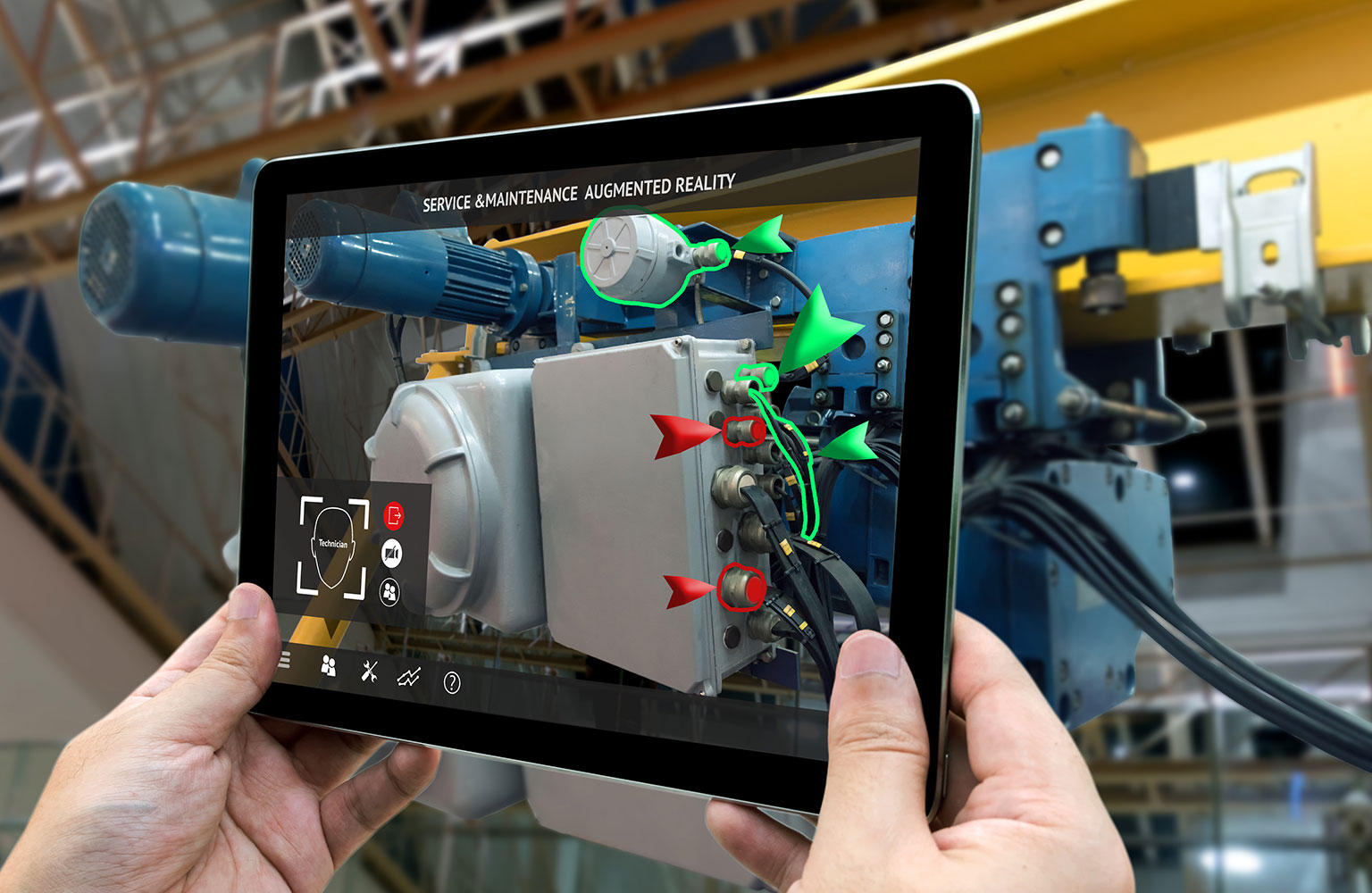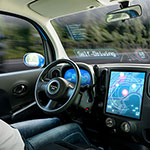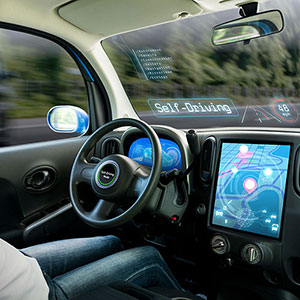

Connect: How technology is changing communication
Augmented Reality Goes to Work
While people wait for the iPhone's augmented reality apps to arrive, AR is already hard at work for some of the biggest firms in the world.
Last summer’s Pokémon Go craze showed us the potential of augmented reality (AR). Apple’s new AR-enabled iPhone 8 and iPhone X will bring the technology to millions more. And 10 years from now we may even find ourselves “holoporting” to work, using AR to interact with colleagues who are half a world away.
But for some of the biggest companies in the world, AR is already on the job. In warehouses, factories, and construction sites, wearable devices like Google’s Glass Enterprise Edition and Microsoft HoloLens are delivering data to workers who one might assume have been largely bypassed by the digital revolution.
Unlike fully immersive virtual reality systems such as the Oculus Rift or HTC VIVE, AR headgear allows users to see and interact with actual objects as well as virtual ones (which is why it’s sometimes also called mixed reality). That makes it ideal for viewing technical manuals, accessing databases, and watching instructional videos while leaving hands free to work.


Exploring what happens when possibility becomes reality.
With the ability to peer through walls and visualize buildings that haven’t been constructed yet, AR can give employees “superpowers,” says Ori Inbar, founder of Super Ventures, a VC firm specializing in AR startups.
“AR helps you perform a task much better than you did before,” he says. “And if there’s a pair of glasses that makes you 50 to 80 percent better at fixing machines or being a surgeon, you’re going to use them.”
Display's the Thing
In 2021, the commercial segment of AR headsets is projected to occupy 82.5 percent of the entire AR headset market, according to research firm IDC.
The reason? Productivity. Having to look at a laptop, tablet, or phone while trying to assemble a complex part for an airplane or a steam turbine can be a productivity killer.
Companies are discovering that giving workers the information they need when they need it—without requiring them to look away from the task at hand—increases their efficiency.
“The classic example is technical manuals,” says Ross Rubin, principal analyst for Reticle Research. “When you’re inspecting a jet engine, an AR headset could replace a 1000-page manual and allow you to bring up information in context as you need it.”
Once companies begin to bring machine learning to AR, he adds, they may be able to spot defects in products just by pointing the headset’s camera at them.
Early examples of AR in the workplace are compelling:
- At Boeing, workers have been using Google Glass to assemble complex wire harnesses for aircraft. Instead of viewing instructions on a laptop, they call up schematics on Glass’s pinky-sized 1080p display and then use voice controls to navigate through the documentation.
According to officials at Boeing Research and Technology, the initial Glass pilot significantly reduced error rates and boosted productivity by 25 percent.
- Samsung has been using Google Glass to speed inventory operations at its Global Parts Center Europe warehouse in the Netherlands. Using AR to pick parts for shipping has reduced errors by 10 percent and increased productivity by up to 22 percent.
- At a GE plant in Florence, Italy, workers use AR to inspect gas turbine nozzles. Requiring more than 100 precise measurements, the process used to take over 8 hours. Now, thanks to AR software, it takes closer to one.
- Service technicians at thyssenkrupp Elevator use Microsoft HoloLens to view service records, safety alerts, and schematics while doing hands-on repairs to elevators at One World Trade Center in New York. AR has helped slash the time needed to complete repairs by more than 60 percent.
The company is also looking to AR to help design home stairlifts for users with mobility problems. Using HoloLens, a thyssenkrupp representative can quickly measure the entire staircase and upload the dimensions to the cloud, enabling the company to design and build stairlifts up to four times faster.
- Technicians at an Airbus factory in Toulouse, France, wear smart glasses from Vuzix while working on the final assembly line for the A330 commercial jet. The smart glasses allow the technicians to position cabin seats and furnishings down to the millimeter, resulting in a zero error rate and an astounding 500 percent gain in productivity.
Model Citizens
AR will also be a huge tool for architects, designers, and construction firms that are already embracing building information modeling (BIM) systems.
BIM allows builders to create a 3D model of a structure and see potential conflicts—like, say, an electrical panel where a door is supposed to be—well before a single piece of rebar has been laid. Manipulating these models using AR allows firms like Mortenson Construction to bring them onto the jobsite.
The Minneapolis-based firm migrated some of its BIM models to a $15,000 DAQRI headset, enabling workers to see where electrical conduit, plumbing, and ductwork would be installed inside a hospital still under construction.
“A big part of that was the ability to use cloud-based BIM360 models and bring them through our workflow,” says Marc Kinsman, an immersive technologies developer for Mortenson. “That’s how you get the ability to see through walls like everyone talks about.”
Mortenson also created a mobile AR app that allows students and faculty at the University of Washington to “see” what its new computer science building will look like when construction is completed in 2019. Using the smartphone camera, the app projects a full-scale model of the building that shows how it will look from wherever you happen to be standing, Kinsman explains.
“Basically you can see into the future to what the campus will look like from that point of view,” he adds.
Mobile Device Management on Steroids
But these productivity gains come at a price. Companies looking to bring AR to their workplace face some daunting technical challenges.
One is bandwidth. Sending sophisticated schematic drawings, CAD files, or video to an untethered device means shuttling a huge amount of data through the air. Existing Wi-Fi networks may need to be re-architected to handle the deluge of packets.
Another challenge is software development. Today, there are relatively few off-the-shelf solutions for enterprise-level AR workloads. In many cases, companies will need to build their own. And most of today’s AR development tools are designed for creating games and virtual environments, not line-of-business applications.
“Most large enterprise and industrial shops have had to not only build their apps, but build their own toolboxes to build the apps,” says Tom Mainelli, a vice president at research firm IDC. “That’s one of the most limiting factors.”
Then there’s the issue of managing these new devices, many of which may also interact with Internet of Things (IoT) sensors embedded in machines and other equipment. This introduces new levels of complexity to a company’s technology portfolio.
Digital workspaces like VMware Workspace ONE™ can simplify the ability to enroll new users by using scripts to enter their login information—crucial for devices where text input options are limited or nonexistent—as well as handle security for each endpoint.
Eventually, AR gear will be handled much the same way other mobile devices are today, notes Aviad Almagor, director of the mixed reality program at Trimble. The company has developed a HoloLens app that lets architects create 3D holograms of buildings while they’re still being designed.
But for now these devices are likely to be shared among coworkers, which raises its own series of complications, Almagor notes.
“The way mixed reality devices are interacting with data and the type of supported use cases will require efficient management of aspects such as tracking, ownership, access control, privacy, and regulatory issues,” he says.
Visualizing the Future
Right now, AR is still in its infancy. Useful mobile apps are just starting to appear, while AR headgear is still too expensive and ungainly looking for use outside factory floors or maintenance environments.
But as the technology improves and gets less expensive and more consumer friendly, it will find its way into everyday objects and work environments. And as it evolves, AR will be used less for information retrieval and more for data visualization, notes Rubin.
“AR will allow employees to play with different data sets and explore them from different perspectives,” he says. “Employees could walk through a retail environment and see how foot traffic looked in certain sections of a store. Or they could look at a piece of merchandise and overlay the sales figures for that SKU over the past three months. It will be useful for any application that frees people from having to look at a screen at a particular time, and overlay information in a way that sparks insights that might not otherwise be available in that environment.”
AR will impact our work lives in a wide range of ways, from training and data retrieval to remote collaboration and business intelligence. It will also change how we experience games, movies, advertising, and more, in ways we haven’t yet imagined.
One thing’s for certain: The future will be augmented. Tighten the straps on your AR headgear and get ready to dive in.

The Possibility Report is an ongoing series about how technology is changing our understanding of the world around us. This article is part of CONNECT, our discussion about how emerging technologies could change how we communicate and bring unprecedented numbers of people online.









